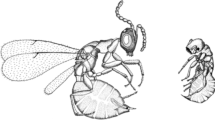Summary
Many fig wasp species have dimorphic males. These males often mate in different localities; one typically disperses before mating whereas the other does not disperse. In 1979 a model was developed for offspring allocation in dimorphic fig wasps, but it assumed that females only lay a single egg per fig. This assumption is not realistic and precludes any effects local mate competition (LMC) may exert on morph abundance. I develop a model without these restrictions and show that the optimal proportions of each morph is determined by two parameters. Firstly, the proportion of the non-dispersing morph is affected by the mean number of females that oviposit in a patch. This effect is due to the negative correlation between LMC between brothers and the number of females that oviposit in a patch. Secondly, the proportions of both male morphs correlate with the expected proportion of females which will mate with each morph. The separation of the two parameters generalizes the model to any other species which is spatially structured and which has two male morphs or even two alternative mating strategies. A comparison of two models shows that parent—offspring conflict involving morph ratios will not have far reaching consequences. I test these models using the 1979 model's data and both models accurately predict the variation in morph ratios in six species of dimorphic fig wasps.
Similar content being viewed by others
References
Bulmer, M.G. and Taylor, P.D. (1980) Dispersal and the sex ratio.Nature 284 448–9.
Frank, S.A. (1985) Hierarchical selection theory and sex ratios. II. On applying the theory, and a test with fig wasps.Evolution 39 949–64.
Frank, S.A. (1986) The genetic value of sons and daughters.Heredity 56 351–4.
Gadgil, M. (1972) Male dimorphism as a consequence of sexual selection.Am. Nat. 106 574–80.
Hamilton, W.D. (1967) Extraordinary sex ratios.Science 156 477–88.
Hamilton, W.D. (1972) Altruism and related phenomena, mainly in the social insects.Ann. Rev. Ecol. Syst. 3 192–232.
Hamilton, W.D. (1979) Wingless and fighting males in fig wasps and other insects. InSexual selection and reproductive competition in Insects (M.S. Blum and N.A. Blum, eds) pp. 167–220. Academic Press, New York.
Herre, E.A. (1985) Sex ratio adjustment in fig wasps.Science 228 896–8.
Maynard Smith, J. (1982)Evolution and the Theory of Games. Cambridge University Press, Cambridge, UK.
Nefdt, R.J.C. (1989) Interactions between fig wasps and their host figs. MSc Thesis, Rhodes University, Grahamstown, RSA.
Suzuki, Y. and Iwasa, I. (1980) A sex ratio theory for gregarious parasitoids.Res. Pop. Ecol. 22 366–82.
Taylor, P.D. (1988) Inclusive fitness models with two sexes.Theor. Pop. Biol. 34 145–68.
Taylor, P.D. (1993) Female-biased sex ratios under local mate competition: an experimental confirmation.Evol. Ecol. 7 306–8.
Taylor, P.D. and Bulmer, M.G. (1980) Local mate competition and the sex ratio.J. Theor. Biol. 86 409–19.
Vincent, S. (1991) Polymorphism and fighting in male fig wasps. PhD Thesis, Rhodes University, Grahamstown, RSA.
Author information
Authors and Affiliations
Rights and permissions
About this article
Cite this article
Greeff, J.M. Offspring allocation in structured populations with dimorphic males. Evol Ecol 9, 550–558 (1995). https://doi.org/10.1007/BF01237836
Issue Date:
DOI: https://doi.org/10.1007/BF01237836




